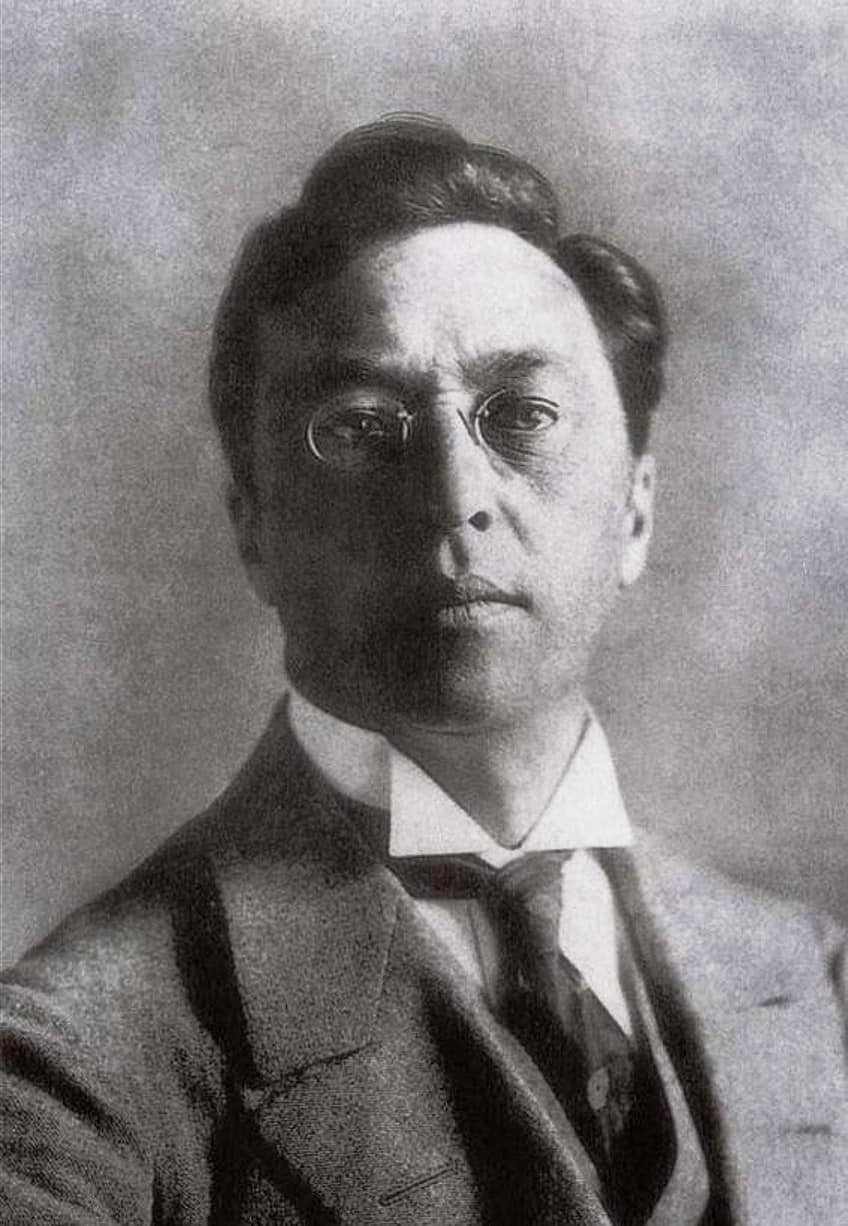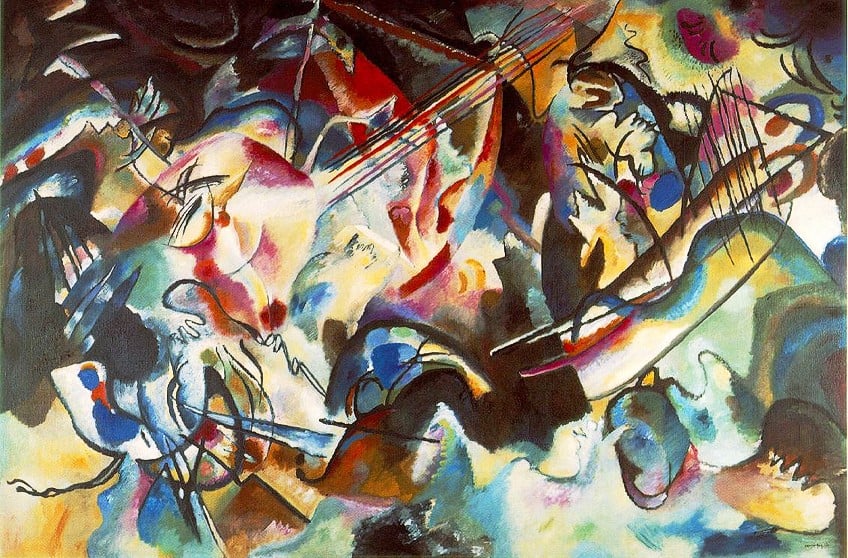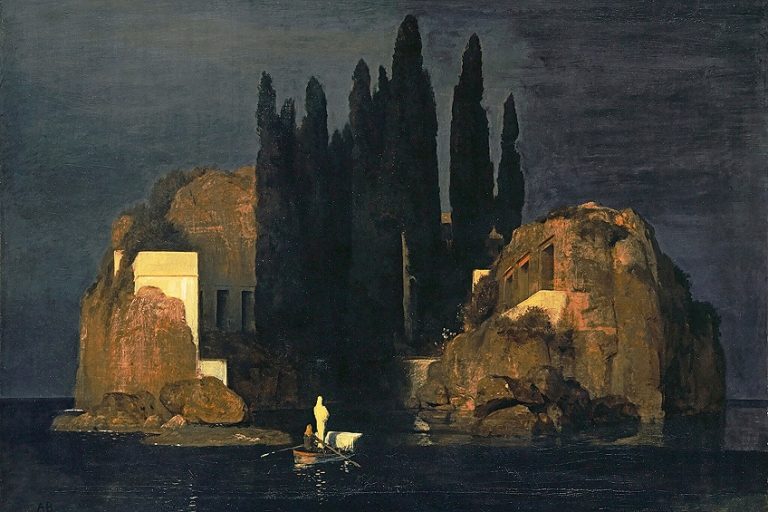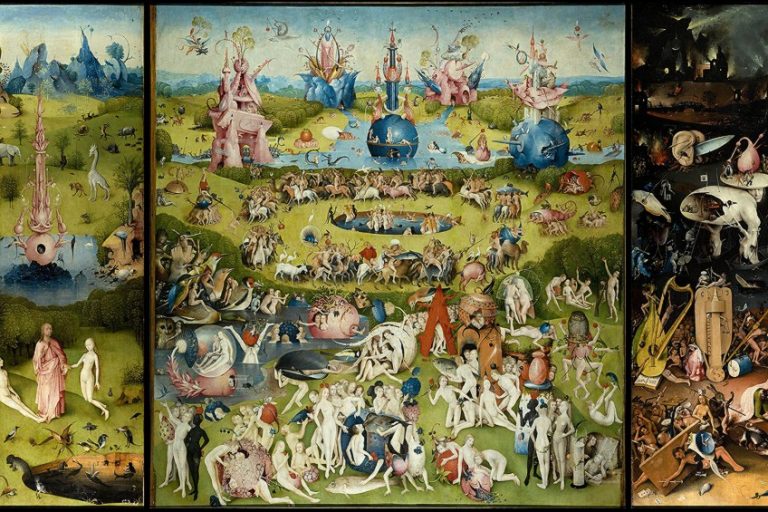“Composition VII” by Wassily Kandinsky – Famous Abstract Art
How do you paint music? Well, this is what one of the pioneering artists of modern art did, and who paved a path for abstract art through his unique visual Compositions. This was Wassily Kandinsky, and this article will discuss his Composition VII (1913).
Artist Abstract: Who Was Wassily Kandinsky?
Wassily Kandinsky was a Russian artist active during the late 19th and early 20th centuries; he was born on December 4 (this is noted as December 16 on the “New Style” or “Gregorian” calendar system), in 1866, and died on December 13, 1944, in Neuilly-sur-Seine in France.
His birthplace was Moscow, but he grew up in the Ukrainian city of Odesa. His studies included the Odesa Art School and the Academy of Fine Arts in Munich, among others.

He was best known for his love and in-depth understanding of colors in art and the deeper spiritual ideas in abstract art. Some of his well-known artworks include Composition IV (1911), Landscape with Red Spots (1913), and Composition VIII (1923).
Composition VII (1913) by Wassily Kandinsky in Context
| Artist | Wassily Kandinsky |
| Date Painted | 1913 |
| Medium | Oil on canvas |
| Genre | Abstract art |
| Period/Movement | Abstract art |
| Dimensions (cm) | 200.6 x 302.2 |
| Series/Versions | N/A |
| Where Is It Housed? | Tretyakov Gallery, Moscow, Russia |
| What It Is Worth | Uncertain |
The Composition VII painting analysis below will discuss a brief socio-historical background around when Wassily Kandinsky painted it and what the possible meanings of it are. This will include a formal analysis of the subject matter and how the art elements are arranged.
Contextual Analysis: A Brief Socio-Historical Overview
Wassily Kandinsky was one of the foremost German Expressionists from the sub-group called Der Blaue Reiter, which means “The Blue Rider” in German. The group reportedly formed around 1909 with Kandinsky and Franz Marc at the helm. The artistic style formed from the artists’ desire to express the deeper spiritual and emotional meanings found through the more abstract and nonrepresentational mode of colors, forms, and lines.
Furthermore, music was a large influencing factor in how Kandinsky made his art, and as with any artist, to understand Kandinsky’s artwork is to understand the man himself and what he experienced and believed.

He perceived the world differently and many report that he may have had the neurological condition known as Chromesthesia, which is also known as sound-to-color synesthesia where the hearing and visual senses overlap. This condition would have undoubtedly influenced Kandinsky’s approach to art making and how he perceived music, which led to his dynamic and colorful abstract vistas on canvas.
Kandinsky’s Composition Series
Kandinsky created several series of paintings for which he became well known, namely his Improvisation, Impression, and Composition series. These were mentioned in what was known as his treatise Concerning the Spiritual in Art (1911). This publication explores the artist’s theories and beliefs around the spiritual aspects of art, but also how he perceived colors and forms and their inherent symbolism and psychological effects on us, the viewers.
The “Composition” series was painted over several decades, from 1910 to 1939, and comprised 10 paintings.

However, three were reportedly destroyed during the bombings and destruction caused during World War II. The seven remaining Compositions depict Kandinsky’s move beyond representational art and into the realms of abstract art. Composition VII, otherwise Composition 7, has often been lauded as one of Kandinsky’s most seminal artworks from this series.
Formal Analysis: A Brief Compositional Overview
In the Composition VII painting analysis below, you will learn more about the subject matter of Composition VII by Wassily Kandinsky. This composition is furthermore composed by the elements of art, which will also be discussed.

Subject Matter: Visual Description
The Composition VII painting is an abstracted, non-representational world filled with a rainbow of colors and a motley array of lines, shapes, and forms on canvas. Although it appears confusing and like there is no purpose to it, Kandinsky had a driving force moving him to paint, which is also evidenced by his numerous preparatory studies.
There are also preparatory sketches for this oil on canvas namely the watercolor titled Untitled (Study for Composition VII, Première Abstraction) (1913), which depicts Kandinsky’s characteristic non-representational formations, albeit to a lesser extent compared to the finished work. However, Kandinsky reportedly produced over 30 preparatory sketches for Composition VII.
Color
In the Composition VII painting, Kandinsky utilized a wide range of colors, from primary blues, yellows, and reds to secondary greens, oranges, and purples. However, the artist’s color combinations go beyond these into tertiary colors like the red-orange in the lower right corner. Neutral colors like blacks and whites are also visible amidst the variety of colors.
Notice the thicker black lines in the central area and various black scattered shapes throughout the composition. There are also more solid areas of off-white scattered throughout.
Texture
The application of the paint and brush in Composition VII by Wassily Kandinsky appears somewhat smooth in its tactile qualities, which is the physical appearance of the paint on the canvas. However, there also appears to be a rougher texture in some areas with the brushstrokes appearing more haphazard in their application.
Line
There are varieties of lines in Composition VII by Wassily Kandinsky, including all orientations like horizontal, vertical, and diagonal, notice the long diagonally curved line to the left of the composition. There are straight, curved, curly, and zig-zagged lines, including a combination of sizes, from long to short, thick to thin, for example, notice the thick and thin black lines arranged in the central area.
Shape and Form
Shapes and forms dominate Kandinsky’s Composition VII painting, and just like the variety of lines, there are almost all types of shapes included here. Furthermore, there are organic and geometric shapes and forms that overlap or cut across each other. To mention only a few examples, notice the white ovular shape at the top edge with a blue and red edge around it. Slightly off-center to the right is an open square-like shape in the lower left part of the composition.
The shapes in the center of the composition consist of rounded formations with overlapping lines that create rectangular shapes.
Slightly above and to the left of these are several curved vertical lines with shorter horizontal lines criss-crossed over it and intercepting this formation is a long reddish diagonally curved line making its way towards the upper left corner of the composition. The other art elements like color and contrasts of light and dark shading create almost three-dimensional forms, for example, notice the large and seemingly amoebic or organ-like form in the lower right corner or the snake-like form towards the bottom left of the composition.
Space
In the Composition VII painting, Kandinsky utilizes the entire canvas space with his non-representationalism. There is almost no sense of three-dimensionality, and the composition can appear two-dimensional or flat, however, through the art elements like color and texture an illusion of depth is created.
The Principles of Art at Play
Composition VII, alternatively Composition 7, is a uniquely executed painting where the subject matter intricately links with the elements of art, in fact, the latter becomes the subject matter, but with deeper spiritual meanings that Kandinsky attached to it. As the art elements were discussed individually, these also lead to how the principles of art, otherwise also known as the principle of design, appear.
Through Kandinsky’s utilization of color combinations, which provides variety, a sense of balance and harmony is also attained.

Furthermore, the variety created by the different types of lines created dynamism and movement in the composition. It comes alive, so to say, and the lines dance with the shapes and forms. Although there is an apparent sense of disarray here in the Composition VII painting, the irregularity creates a sense of unity within the composition, where all the elements are cohesive in their contrasts.
The Sounds of Kandinsky
Wassily Kandinsky developed his own language, so to say, of painting, which is what this article explored by focusing on one of his greatest artworks, Composition VII. The artist paved the way for abstract art during the modern age and represented the non-representational through his eyes.

While this article discussed Kandinsky’s seventh painting in his “Composition” series, and touched on some of the important concepts surrounding his art, you are encouraged to delve deeper into the rhythmic sea of Kandinsky’s forms and colors, sliding from one curved line, splashing into a bean-shaped pool of blue!
Frequently Asked Questions
Who Painted Composition VII?
The Russian abstract artist Wassily Kandinsky painted Composition VII (1913). It is an oil on canvas and measures 200.6 by 302.2 centimeters and has become one of the artist’s most notable artworks.
Where Is Composition VII by Wassily Kandinsky Located?
Composition VII (1913) by Wassily Kandinsky is housed at the Tretyakov Gallery in Moscow, Russia.
What Is the Meaning of Composition VII by Wassily Kandinsky?
Composition VII (1913) by Wassily Kandinsky, although abstract, holds symbolic significance related to the Biblical story about the Flood and Noah, among others. The artist was also believed to touch on deeper emotional aspects through the composition.
Alicia du Plessis is a multidisciplinary writer. She completed her Bachelor of Arts degree, majoring in Art History and Classical Civilization, as well as two Honors, namely, in Art History and Education and Development, at the University of KwaZulu-Natal, South Africa. For her main Honors project in Art History, she explored perceptions of the San Bushmen’s identity and the concept of the “Other”. She has also looked at the use of photography in art and how it has been used to portray people’s lives.
Alicia’s other areas of interest in Art History include the process of writing about Art History and how to analyze paintings. Some of her favorite art movements include Impressionism and German Expressionism. She is yet to complete her Masters in Art History (she would like to do this abroad in Europe) having given it some time to first develop more professional experience with the interest to one day lecture it too.
Alicia has been working for artincontext.com since 2021 as an author and art history expert. She has specialized in painting analysis and is covering most of our painting analysis.
Learn more about Alicia du Plessis and the Art in Context Team.
Cite this Article
Alicia, du Plessis, ““Composition VII” by Wassily Kandinsky – Famous Abstract Art.” Art in Context. June 5, 2023. URL: https://artincontext.org/composition-vii-by-wassily-kandinsky/
du Plessis, A. (2023, 5 June). “Composition VII” by Wassily Kandinsky – Famous Abstract Art. Art in Context. https://artincontext.org/composition-vii-by-wassily-kandinsky/
du Plessis, Alicia. ““Composition VII” by Wassily Kandinsky – Famous Abstract Art.” Art in Context, June 5, 2023. https://artincontext.org/composition-vii-by-wassily-kandinsky/.











